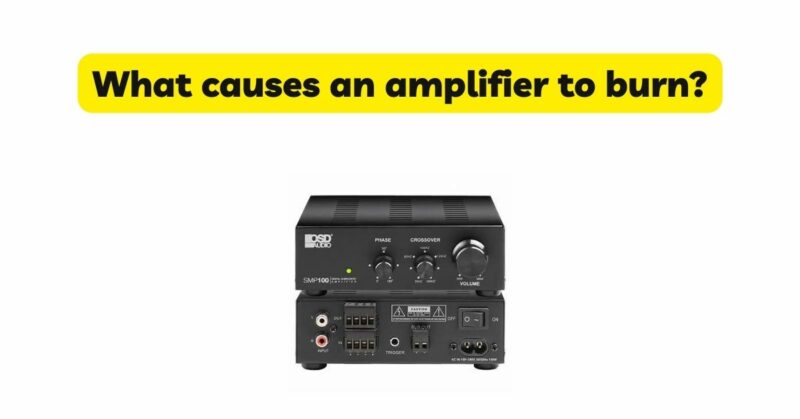Amplifiers are essential components in audio systems, amplifying audio signals and powering speakers. However, like any electronic device, amplifiers are susceptible to failure, and one of the most concerning issues is amplifier burnout. Amplifier burns occur when the internal components of an amplifier become damaged or destroyed due to excessive heat or other factors. In this article, we will explore the various causes of amplifier burnouts, shedding light on the factors that contribute to these failures and providing insights into how to prevent them.
Understanding Amplifier Burnouts: The Basics
Before delving into the causes of amplifier burnouts, it is important to have a basic understanding of how amplifiers work and the components involved.
Amplifiers receive low-level audio signals and amplify them to a level suitable for driving speakers. They consist of several key components, including transistors, capacitors, resistors, and power supply units. These components work together to process the audio signal and deliver it to the speakers.
Causes of Amplifier Burnouts
- Excessive Heat Generation
One of the primary causes of amplifier burnouts is excessive heat generation. When an amplifier operates, it generates heat as a byproduct. If this heat is not effectively dissipated, it can accumulate and damage internal components. Several factors can contribute to excessive heat generation:
a. Inadequate Ventilation: Poor airflow and insufficient ventilation can impede heat dissipation. Placing the amplifier in a confined space, covering the ventilation grilles, or stacking equipment closely together can restrict airflow and lead to heat buildup.
b. High Ambient Temperature: Operating an amplifier in an environment with high ambient temperature can exacerbate heat-related issues. If the surrounding temperature is already elevated, the cooling mechanisms of the amplifier may struggle to dissipate the heat effectively, putting additional stress on the components.
c. Overdriving the Amplifier: Pushing the amplifier beyond its recommended limits, such as playing audio at maximum volume or driving it into clipping, can cause it to work harder and generate excessive heat. Continuous operation under such conditions can result in component failure or burnouts.
- Power Supply Issues
Power supply problems can also contribute to amplifier burnouts. Insufficient power supply voltage or current can cause the amplifier to draw more current than it can handle, leading to overheating and eventual failure. Conversely, power supply surges or irregularities, such as voltage spikes or fluctuations, can damage the amplifier’s components.
- Incorrect Load Impedance
Impedance mismatching is another factor that can cause amplifier burnouts. Amplifiers are designed to operate with a specific range of speaker impedances. Connecting speakers with an impedance that is too low for the amplifier can overload it, causing excessive current flow and generating excessive heat, leading to component damage.
- Component Failure
Amplifier burnouts can also occur due to component failure. Although relatively rare, components such as transistors, capacitors, or resistors can fail, causing malfunctions or generating excessive heat. Manufacturing defects, poor quality control, or extended periods of usage can contribute to component failures.
Preventing Amplifier Burnouts: Best Practices
Prevention is crucial when it comes to avoiding amplifier burnouts. Here are some best practices to protect your amplifier and prolong its lifespan:
- Ensure Adequate Ventilation: Provide proper airflow and ventilation for your amplifier. Place it in an open area with sufficient clearance around it to allow for efficient heat dissipation. Avoid enclosing the amplifier in cabinets or racks without adequate ventilation.
- Monitor Ambient Temperature: Keep the amplifier in an environment with a controlled temperature. Avoid placing it near heat sources or in direct sunlight. If operating in warm environments is unavoidable, consider using additional cooling methods, such as fans or dedicated cooling systems.
- Match Impedance Correctly: Ensure that the speakers connected to your amplifier have the appropriate impedance rating. Refer to the specifications of both the amplifier and the speakers to ensure proper impedance matching. This will prevent undue strain on the amplifier and minimize the risk of burnouts.
- Use a Stable Power Supply: Connect your amplifier to a stable and clean power supply. Consider using power conditioners or surge protectors to guard against power surges and fluctuations. Verify that the power supply voltage and current meet the amplifier’s requirements.
- Avoid Overdriving the Amplifier: Use the amplifier within its recommended power ratings and avoid continuous operation at maximum volume or in clipped conditions. Monitor the audio levels and keep them within a safe range to prevent excessive heat generation.
- Perform Regular Maintenance: Conduct regular maintenance on your amplifier. Check for loose connections, inspect cables for damage, and clean the amplifier’s exterior. Schedule professional inspections and servicing to detect and address any potential issues before they escalate.
Conclusion
Amplifier burnouts can be a significant concern for audio enthusiasts and professionals alike. Excessive heat generation, power supply issues, incorrect load impedance, and component failures are common culprits behind these failures. By understanding the causes of amplifier burnouts and implementing preventive measures such as adequate ventilation, proper impedance matching, stable power supply, and responsible usage, you can minimize the risk of amplifier burnouts and ensure the longevity and performance of your audio equipment.

